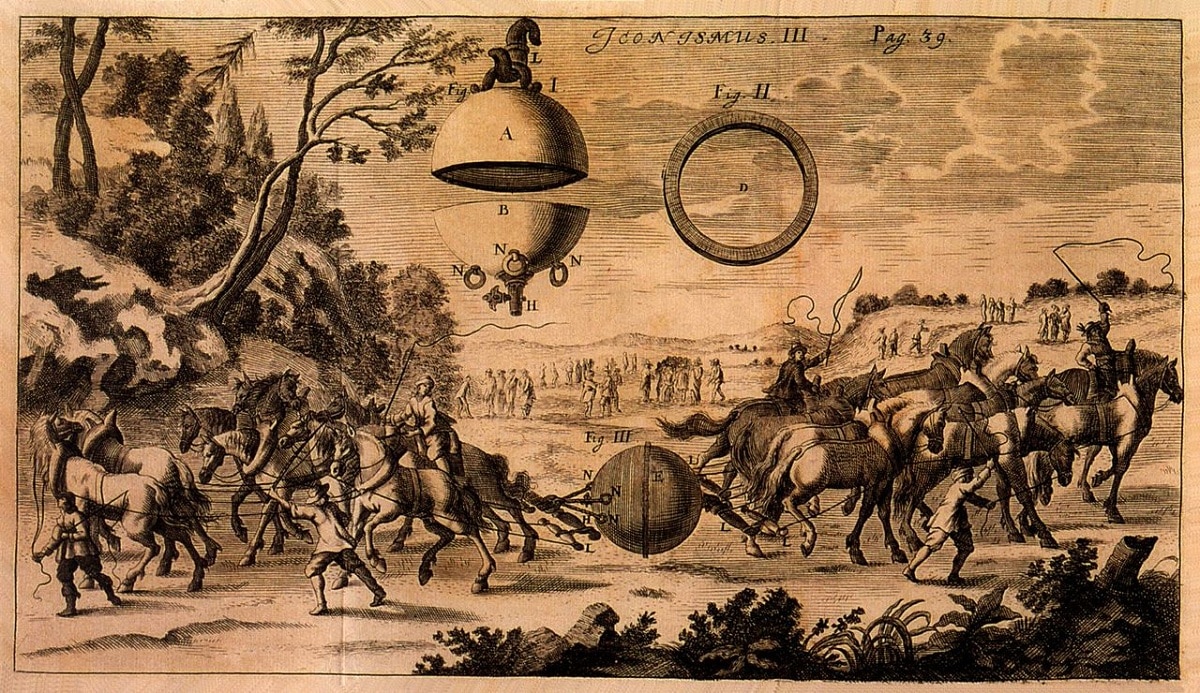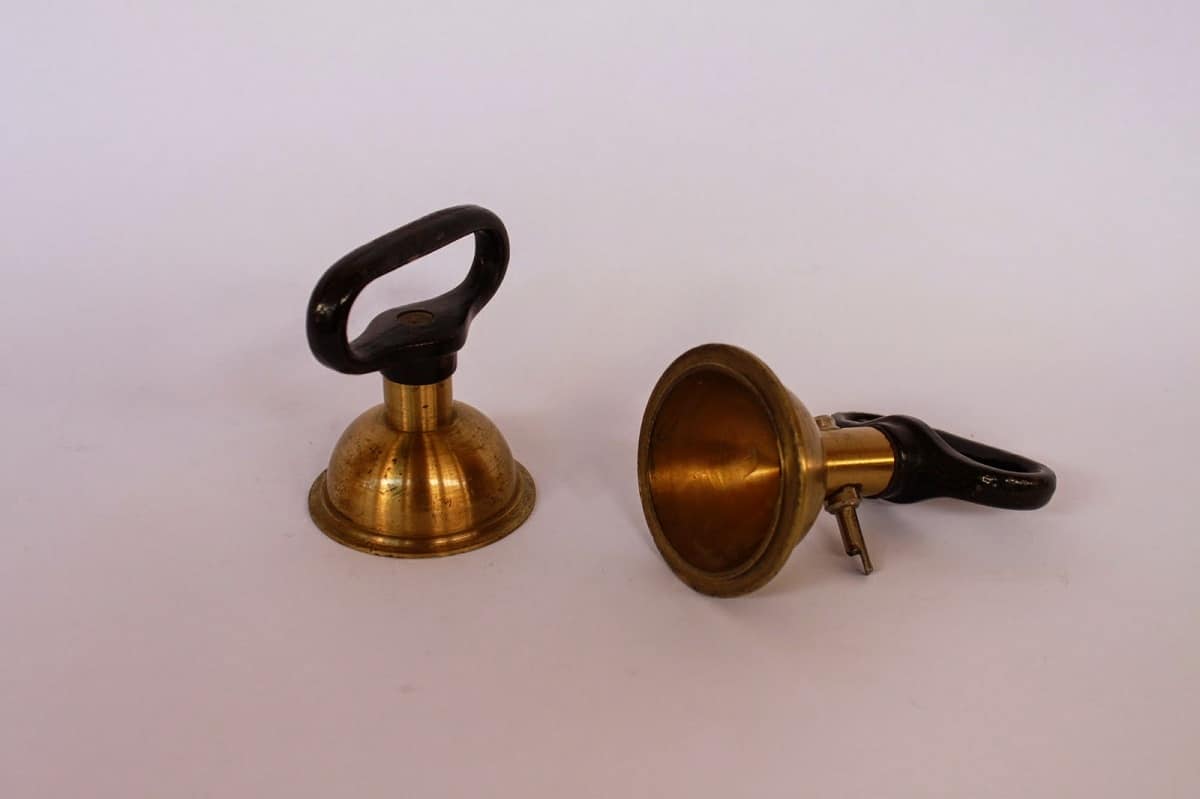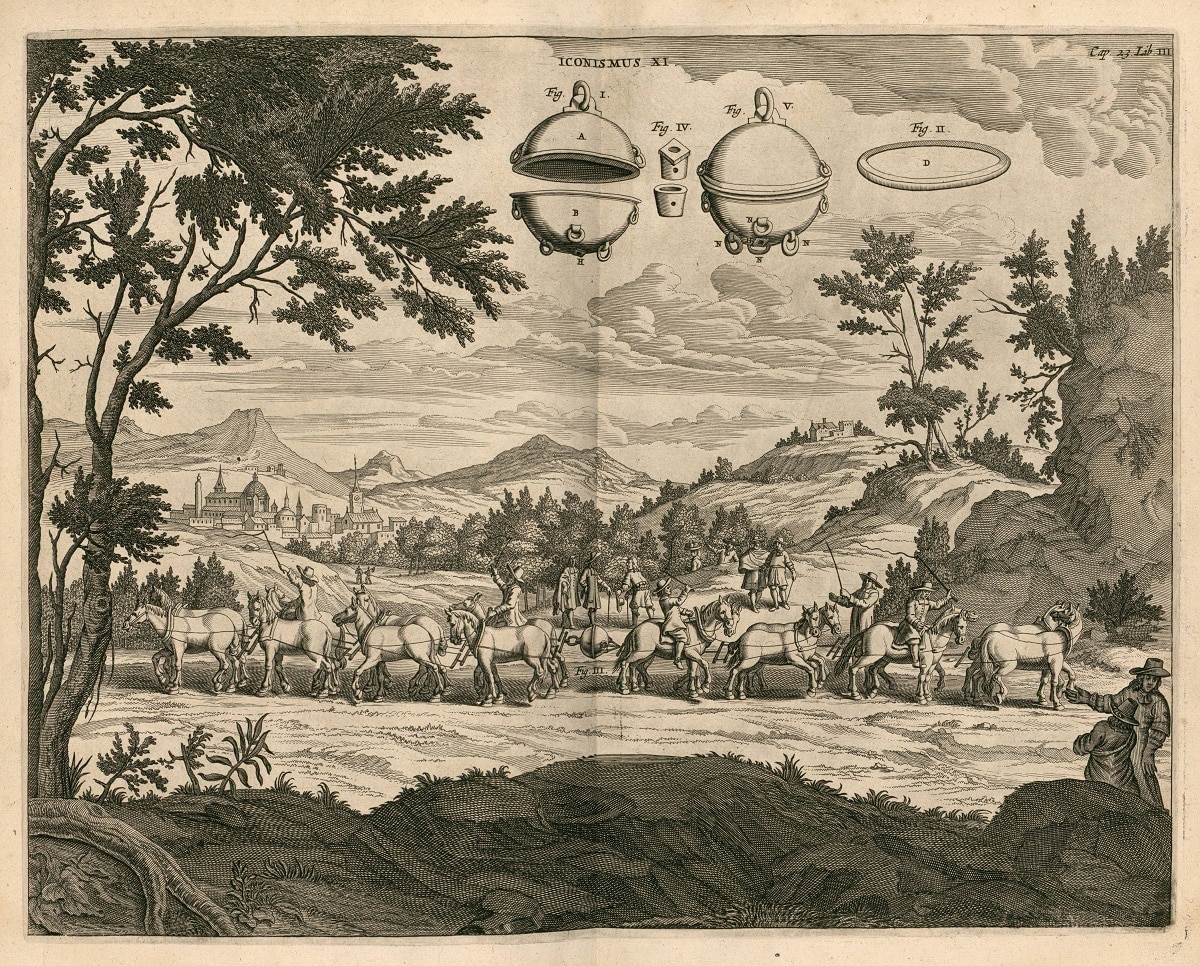
On May 8, 1654, in the German city of Magdeburg, Emperor Ferdinand III and his entourage demonstrated a spectacular experiment designed and carried out by the city's mayor, the German scientist von Glick. Several carvings from the time reflect this event. It's about the magdeburg hemispheres. The experiment consisted of trying to separate two metal hemispheres about 50 centimeters in diameter, joined by simple contact, to form a sealed sphere, and incidentally, pump air out of the sphere with a vacuum pump of his own invention. To facilitate the sealing of the metal hemisphere or hemispheres, a leather ring is placed between the contact surfaces. Each hemisphere has several loops through which a rope or chain can be passed so that it can be pulled to opposite sides.
In this article we are going to tell you everything you need to know about the Magdeburg hemispheres experiment and its importance.
Magdeburg Hemispheres

It is a device designed to demonstrate the existence of a vacuum and atmospheric pressure. It consists of two hollow hemispheres, and if they are connected to each other and the air inside is drawn, an internal vacuum will be created. Under these conditions, the atmosphere exerts pressure on the outer surface, making it very difficult to separate the debris. In fact, these had to be very strong, because once the interior was evacuated, it would be capable of bursting them at atmospheric pressure.
These hemispheres, named after the German city of Magdeburg, they were used to perform a strange experiment in 1654. Otto von Guericke, mayor of the city and professional physicist, in the presence of Elector Frederick William of Brandenburg and members of the Regensburg Parliament, practiced vacuuming on two metal hemispheres.
Experiment

In an attempt to separate them, tied one hemisphere to a group of horses and the other to an equal number of horses, but in opposite directions. After numerous attempts and to the surprise of the attendees, it was impossible to separate the two halves of the sphere. The effect is similar to what we achieve when we place two drain plungers at the bottom and press them against each other. A vacuum is incomplete, but it takes a lot of force to separate them.
Spectators were amazed to see the different groups of men pulling sideways with all their might and failing to separate the hemispheres. They also could not be initially separated by 16 horses, divided into two groups of 8 horses each. After hard work, they achieved their goal and caused quite a stir. The hemispheres that made up the spheres, which required a lot of effort to open, could be effortlessly separated simply by allowing air to re-enter the interior of the spheres.
In a 2005 experiment with 16 horses in Granada, hemispheres could not be separated. Keep in mind that the vacuum achieved by the XNUMXth century Von Guericke pumps was lower than that achieved by our modern vacuum pumps.
Why it is difficult to separate the hemispheres of Magdeburg

The first part of the question, at this point, is easy for any high school student with a good understanding of physics to answer. Everything on the Earth's surface is in a sea of heavy air, subject to forces normal to its surface in all directions. In the same way, are received by the hemisphere, inside out and outside in. If once the hemispheres are closed to form a sphere, almost all the air inside is removed and the force on the outer surface presses them much more than the air acting outwards, making it difficult for them to separate.
The net force that squeezes the two hemispheres, distributed throughout the formed sphere, that is, assuming that the vacuum achieved inside is about 10% of the outside air, must overcome the force that separates them, it is of the order of seven tons of weight.
Second part of the question, why are the residents of Magdeburg so impressed? It has to do with the knowledge of fluids and their behavior over time. We are in the XNUMXth century, and an important part of the scientific community believed that it was impossible to create a vacuum, the "vacuum terror", which was the cause of the movement of fluids, preventing it from happening.
So, by sipping the liquid from the glass through a straw, thus removing some of the air it contains, the horror that nature feels when it is empty causes the liquid to rise. In the historic moment of conducting experiments, scientists like Torricelli abandoned this theory and showed that the pressure exerted by the atmosphere, the weight of the air, not the horror of the vacuum.
Explanation of the experiment
To understand what Emperor Ferdinand III witnessed, we must remember that our lives take place in a vast ocean of air, and this, like any fluid, has mass, so a given volume of air has a weight capable of exerting a force on it. he. But these forces act more than like a pile of bricks placed on our heads. Things are a bit more complicated because every object submerged in this sea of air is subjected to a set of forces that tend to compress it, acting at every point on its surface. Furthermore, these forces are always applied perpendicular to the surface in question.
Likewise, if air is enclosed in a container, the walls of that container will experience a force normal to its surface at every point, causing it to expand. To understand this phenomenon in more detail, we must remember that air is made up of a large number of molecules, which you can imagine as microscopic spheres that move randomly in all directions, crashing and bouncing off everything in its path. Each of these small collisions produces a small force which, combined with the countless hits that occur non-stop every second, can create quite a bit of force. The net effect of this constant molecular impact is a set of point forces that are always perpendicular to the impact surface.
I hope that with this information you can learn more about the Magdeburg hemispheres and their characteristics.